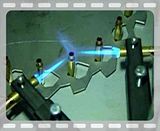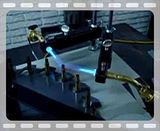Gentlemen;
My 7x57 case necks needed to be drawn back soft - I was loosing about 1.5% every time I reloaded them due to cracks.
I lit-off my plumber's blow torch and, with a pail of water right close I began.
My technique is to hold each (de-primed) case by the head in my bare fingers and put the neck right into the hottest part of the flame.
Holding the head bare-handed makes it a certainty that I will not anneal that part of the case. The heat of the torch quickly gets the neck red-hot and I dump it into the water to quench just as the head is getting warm in my fingers.
When done each case shows how far down the annealing went ~ just past the shoulder. And the procedure goes quite fast.
Then all that remains is to dry the cases - usually in the sun - and carry on for another reload.
Good morning,
Forrest

|
   
   
|


|



 Reply With Quote
Reply With Quote





















